Seriously Simple Snippets One Page at a Time
Home > Seriously Simple Snippets
 Keep up to date with Seriously Simple Snippets.
Keep up to date with Seriously Simple Snippets.
OPPM and the PMBOK
More than 400,000 professional project managers know that PMBOK is the acronym for A Guide to the Project Management Body of Knowledge. The PMBOK originated as a white paper in 1987, with a first edition book published in 1996, second edition in 2000, third in 2004 and the fourth December 2008. A fifth edition is scheduled for publication in 2013. The Project Management Institute (PMI) describes the PMBOK as the “recognized standard for the project management profession.” PMI further states that it “provides guidelines for managing individual projects. It defines project management and related concepts and describes the project management life cycle and the related processes.”
That being said, still many practicing project managers, and readers of the OPPM books, are not familiar with the PMBOK.
With this Snippet, we desire to provide readers of all experience levels a “seriously simple” visual display of the PMBOK. We will also drill down on Communication Management showing how the OPPM comfortably aligns with PMBOK processes and knowledge areas while accelerating communication effectiveness.
A comprehensive interrelated framework supported by the concept of “processes” undergirds PMI’s view of projects and project management. Processes are a cluster of interconnected activities performed to deliver a planned result. The planned results are the outputs that a process generates by applying various tools and techniques to a collection of inputs. This inputs; tools & techniques; outputs process model is PMBOK’s fundamental building block.
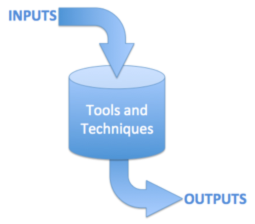
The Guide recognizes 42 different processes (see below) which overlap and interact throughout the phases of a project. Outputs from previous processes become inputs to others, whose outputs then provide inputs to successive groups of processes. Project managers, in collaboration with their project team, must determine which processes are applicable to their specific project.
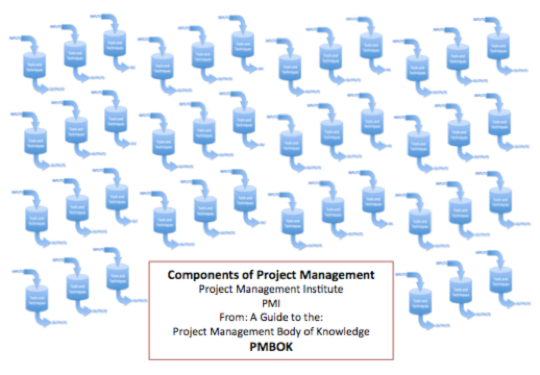
The PMBOK’s 467 pages are largely focused on describing and navigating this maze of interconnectivity. In a brilliant stroke of simplification, they have aligned each process with one-and-only-one of 5 Process Groups, and one-and-only-one of 9 Knowledge Areas thus providing the capability for a 5 by 9 display.
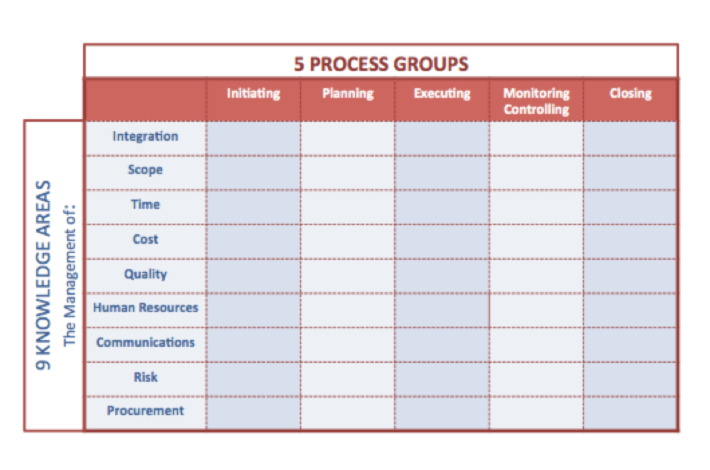
The 5 Process Groups are:
- Initiating – defining and securing authorization to begin.
- Planning – establishing scope and defining the actions required to attain it.
- Executing – performing the work to deliver the plan
- Monitoring and Controlling – tracking progress and handling changes.
- Closing – finalizing activities and formally closing the project.
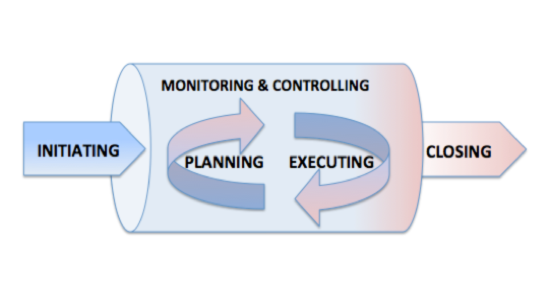
A visual display of the Process Groups helps to see how projects begin with the Initiating group and end with the Closing group. Panning and Execution follow Initiation and are iterative during the project while Monitoring and Controlling operate throughout the project.
The 9 Knowledge Areas are about management. Here, processes are grouped in alignment with the various executing and administrating skills necessary for successfully running a project.
By placing each of the 42 processes into their respective Process Group, and Knowledge Area, we have a seriously simple context or framework enabling us to visualize, from the 30,000-foot level, the full construct of project management.
OPPMs can be an important part of most of the 42 project processes. Communications Management however, is the Knowledge Area where the OPPM can amplify project management performance most directly. As seen above, Communications Management includes five specific processes resident in 4 of the 5 Process Groups.
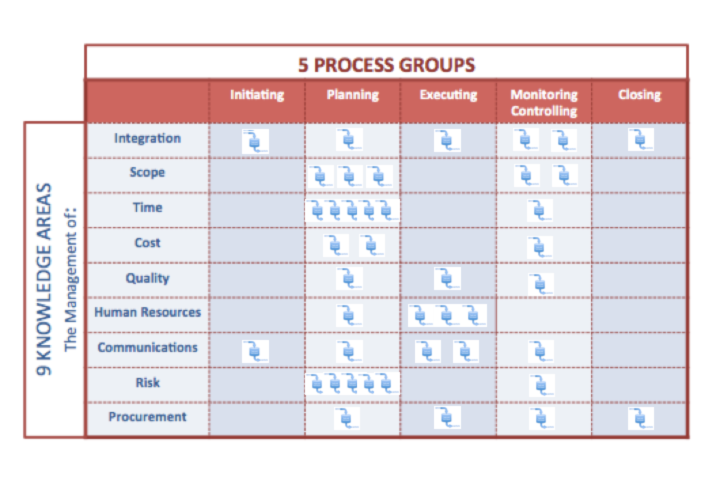
OPPMs and Communication Processes
1. Identify Stakeholder Process: Referencing the project charter and enterprise environmental factors, the project team conducts a stakeholder analysis to identify key stakeholders and then develop a stakeholder management strategy.
OPPM Application – The OPPM documents and communicates the project plan in sufficient, yet efficient detail. Stakeholders that have a clear picture of the project are better prepared to support project efforts. Thinking through the various OPPM building and reporting steps helps identify diverse stakeholder interests.
2. Plan Communications Process: With stakeholders identified, and a stakeholder management strategy plan in hand, the team analyses communication requirements. They utilize communication technology, communication models, and communication methods to prepare a communication management plan.
OPPM Application – The OPPM is constructed to reflect stakeholder requirements. The communication cadence is determined and built into the OPPM. Who updates and releases the OPPM and to whom it will be distributed is determined. It is important for OPPM readers to understand the meaning of open and filled circles and boxes along with the implication of the stoplight colors.
3. Manage Stakeholder Expectations Process: Knowing who they are and what is important to them, the project manager applies effective communication methods together with interpersonal and managerial skills to manage stakeholder expectations. Various plan updates may result.
OPPM Application – OPPMs are easily read, and easily changed. Expectations are clear and concise. Concerns are often addressed before becoming issues. The OPPM displays the what, who, how long and how much, and then addresses the why and what’s next. Frankly, stakeholders like OPPMs; they know more of what they want to know, when they want to know it – on one page.
4. Report Performance Process: With work performance and forecast inputs on scope, schedule and costs, together with quality and risks, the team prepares the project status report.
OPPM Application – The OPPM is the performance report. It shows plan versus actual for costs, tasks, schedule, and risk. Preparation is not difficult or time consuming and stakeholders will read it.
5. Distribute Information Process – Quoting the PMBOK “Performance reports are used to distribute project performance and status information, and should be as precise and current as possible.”
OPPM Application – OPPMs are quickly prepared, therefore current. OPPMs are precise and candid. OPPMs are easily distributed in print and digital formats and may be clearly referenced in web and video conferences.
One final thought. The dimensions of project communication activities are listed in the PMBOK and are shown below. As you read through them, now that you have finished this book, think how OPPMs provide a seriously simple solution within each.
- Internal (within the project) and external (customer, other projects the media, the public)
- Formal (reports, memos, briefings) and informal (emails, ad-hoc discussions)
- Vertical (up and down the organization) and horizontal (with peers)
- Official (newsletters, annual report) and unofficial (off the record communications)
- Written and oral, and
- Verbal and non-verbal (voice inflections, body language)

